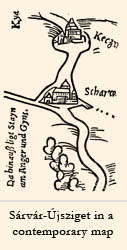 The printing press at Sárvár-Újsziget was the only printing shop in Hungary in the first half of the 16th century which produced books in Hungarian. Founded by the magnate Tamás Nádasdy in his estate Sárvár-Újsziget, in the Western part of Hungary was, at the same time the first private press established by an aristocrat. It was founded very likely with the aim to print the New Testament (RMNy 49) translated to Hungarian by János Sylvester, that is why this press is named after the scholar, as Sylvester-press. Although the humanist philologist was neither the owner, nor the printer of this newly established press, he was in fact its spiritual leader.
The printing press at Sárvár-Újsziget was the only printing shop in Hungary in the first half of the 16th century which produced books in Hungarian. Founded by the magnate Tamás Nádasdy in his estate Sárvár-Újsziget, in the Western part of Hungary was, at the same time the first private press established by an aristocrat. It was founded very likely with the aim to print the New Testament (RMNy 49) translated to Hungarian by János Sylvester, that is why this press is named after the scholar, as Sylvester-press. Although the humanist philologist was neither the owner, nor the printer of this newly established press, he was in fact its spiritual leader.
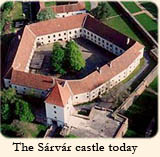 Of the aristocrats living in the court of the Hungarian king influcenced by the Erasmian humanist spirit Tamás Nádasy became one of the richest noblemen, with huge estates and a number of castles situated in the western part of Hungary.
Of the aristocrats living in the court of the Hungarian king influcenced by the Erasmian humanist spirit Tamás Nádasy became one of the richest noblemen, with huge estates and a number of castles situated in the western part of Hungary. 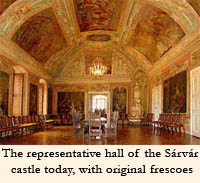 Altough he never left his catholic confession, the spirit of religious reforms was not alien to him. In his court he gave home a number of Hungarian scholars and some outstanding personalities of Hungarian literature, among others the philologist János Sylvester, the lutheran Mathias Dévai Biró. Both with this scholarly environment and with the first book printed in Hungary and in Hungarian, he did great service to Hungarian culture.
Altough he never left his catholic confession, the spirit of religious reforms was not alien to him. In his court he gave home a number of Hungarian scholars and some outstanding personalities of Hungarian literature, among others the philologist János Sylvester, the lutheran Mathias Dévai Biró. Both with this scholarly environment and with the first book printed in Hungary and in Hungarian, he did great service to Hungarian culture.
Preceding Sylvester's New Testament translation some 10-11 books printed partly or wholly in Hungarian have already been published, but each of them abroad: in Vienna or in 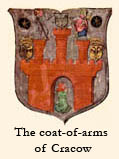 Cracow (the contemporary presses in Hungary in Brassó and Szeben produced at that time only Latin or German books). Neither was a complete New Testament translation at hand before Sylvester, only certain parts were translated to Hungarian, and printed likewise in Vienna and Cracow. Sylvester was also taking part in the translation of Hungarian books while in Cracow, because he attended first the university here, later in Wittenberg he studied as the student of Philiph Melanchthon.
Cracow (the contemporary presses in Hungary in Brassó and Szeben produced at that time only Latin or German books). Neither was a complete New Testament translation at hand before Sylvester, only certain parts were translated to Hungarian, and printed likewise in Vienna and Cracow. Sylvester was also taking part in the translation of Hungarian books while in Cracow, because he attended first the university here, later in Wittenberg he studied as the student of Philiph Melanchthon.
Before setting to print the New Testament, Sylvester's Grammatica (RMNy 39) was issued, as a by-product of the translation. Its dedication is dated from October 15th 1536, when two-thirds of his translation was already done. This grammar, written in Latin, is not only the first product of the press, but also the first Hungarian grammar. 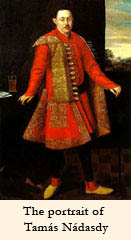 Tamás Nádasdy, who himself studied in different universities, was generously supporting the costs of the press. He invited in 1536 - probably from Vienna - a printer called Johannes Strutius to lead the printing shop. However, neither Nádasdy nor Sylvester was content with his activity. Before finishing the New Testament, he left Sárvár-Újsziget, and left for Ingolstadt. It was a lucky choice that the new printer was Benedek Abádi, formerly a Hungarian proof-reader in the Vietor-office in Cracow and probably a personal acquaintance of Sylvester.
Tamás Nádasdy, who himself studied in different universities, was generously supporting the costs of the press. He invited in 1536 - probably from Vienna - a printer called Johannes Strutius to lead the printing shop. However, neither Nádasdy nor Sylvester was content with his activity. Before finishing the New Testament, he left Sárvár-Újsziget, and left for Ingolstadt. It was a lucky choice that the new printer was Benedek Abádi, formerly a Hungarian proof-reader in the Vietor-office in Cracow and probably a personal acquaintance of Sylvester.
The printing of the New Testament was finished in 1541. Following the hard times after the fall of the capital, Buda, the printing shop erected with so much cost and care, and equipped with Hungarian, Latin, Greek (and wood-cut) Hebrew types, ceased.. From its products there is only a unique copy of Grammatica and several copies of the New Testament that survived. The New Testament is especially richly illustrated: the several hundred pages of the book has a red and black printed title-page, with imposing, wood-cut borders, and more than hundred wood-cuts. With all these it is the finest illustrated book printed in Hungary in the 16th century. The majority of the wood-cuts display a relation to the graphic arts of Vienna, and very likely Vienna was the source where the so-called "bastarde" printing types used in the New Testament were acquired.
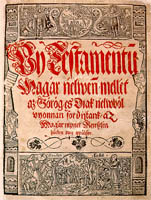 |
The title-page of New Testament (Új Testamentum) with text printed red and black. Not only the large-scale letters of the title-page but some capitals are also cut in wood (RMNy 49)
|
Although Johannes Strutius was apparently not no good in printing, he was a talented wood-cutter. A part of the illustrations - and not only those signed by I. S. - were his works.
The printing paper necessary for the press was bought from merchants, and not directly from paper-mills, as it can be deduced from the papers with different water-marks. The various water marks hint at Southern-German and Italian origins.
Soon after finishing the printing of the New Testament the press founded by Nádasdy ceased its activity. The printer, Benedek Abádi enlisted in 1543 to the Wittenberg university, while János Sylvester was invited to the Vienna university as a scholar of Hebrew language. Almost the whole printing equipment together with the type-faces disappeared, there are only some wood-cut ornaments which survived. Some unkown way they went over into the possession of the protestant printer Gál Huszár, who used an ornament in 1562 in Debrecen, and from him, together with a decorated initial, to another protestant printer Péter Bornemisza. He used these two pieces in his printings until 1578.

TYPE FACES
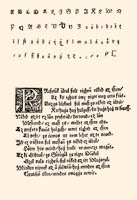 |
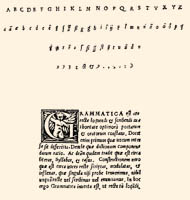 |
The New Testament was printed with the special, unusual, so-called "bastarde" type |
The renaissance italic type of Grammatica |

ORNAMENTS AND ILLUSTRATIONS
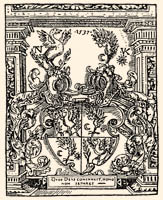 |
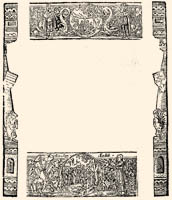 |
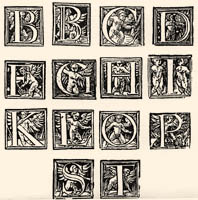 |
The united coats of arms of Tamás Nádasdy and Orsolya Kanizsay in the New Testament was probably cut in Vienna |
The large, imposing composition framing the New Testament consists of four wood-cut pieces. At the sides the coats of arms of Hungary and Tamás Nádasdy respectively his wife Orsolya Kanizsay. Above and below scenes from the Old Testament: prophets, Loth's wife, Samson and Judith and the copper serpent in the medallion |
The series of decorated initials of the Sárvár-Újsziget press with puttos
|
|
|
The first page of Grammatica (RMNy 39) with an initial representing a putto |
Some of the series of 100 small wood-cut illustrations decorating and explaining the New Testament |
|
|
The wooden block representing Apostle Matthaeus was twice re-modelled, as it can be seen in the New Testament |
The woodcut representing Adam and Eve was originally part of the border framing the title page of Grammatica. It survived the Sárvár-Újsziget press and cropped up in 1562 at the other end of the country in Debrecen. Later the unique wooden block apparently returned to the northern-western part of Hungary, to Sempte, where it was used in Peter Bornemisza's printing shop until 1578 |

type faces - ornaments and illustrations
<<back to the top <<

LITERATURE:
Soltész Zoltánné: A sárvár-újszigeti nyomda könyvdíszei. Bp. 1955 /Az Országos Széchényi Könyvtár kiadványai, 33./
Fazakas József: A sárvár-újszigeti nyomda papirosai. Bp. 1957 /Az Országos Széchényi Könyvtár kiadványai, 39./
Varjas Béla: A sárvár-újszigeti nyomda betűtípusai, In: ItK 1958. 140-151.
Sylvester János: Új Testamentum. Újsziget 1541, hasonmás kiadás. A kísérő tanulmányt írta Varjas Béla. Bp. 1960. /Bibliotheca Hungarica Antiqua 1./
Balázs János: Sylvester János és kora. Bp. 1958.
V. Ecsedy Judit: A régi magyarországi nyomdák betűi és díszei. Bp. 2004. 44-52, 211-235. /Hungaria typographica 1.